A South African pilot landed immediately after a cobra reportedly slithered onto his hip during a flight.
RELATED STORIES: Man Bitten By “Dead” Venomous Snake Inside Snake Wine Jar That Was Sealed For A Year
Rudolf Erasmus was flying four people in a small twin-prop plane when he noticed something cold was rubbing against his skin from under his shirt. Initially, he assumed his water bottle was leaking on him until he noticed the cobra slithering on his body. He said he recognized that the serpent was actually a venomous Cape cobra that could kill nine people with one bite.
“I felt this cool sensation, sort of, crawling up my shirt. As I turned to the left and looked down, I saw the cobra… receding its head backwards underneath the seat.”
Erasmus attempted to grab the cobra and managed to get it under control by not telling the passengers that the animal was onboard. However, he had to tell them eventually that the cobra was under his seat, and surprisingly, the passengers were very calm about the situation.
“I did inform the passengers: ‘Listen the snake is inside the aircraft, it’s underneath my seat, so let’s try and get down to the ground as soon as we can.'”
RELATED STORIES: Doctors Pull 4-Foot Snake Out Of Woman’s Throat After It Slid In While She Slept
After the plane landed, he pulled his seat forward, and the cobra was curled under it, but it later disappeared after investigators inspected the plane.
Snakes on a Plane is real? pic.twitter.com/pw9BzEV4FW
— C.⚜️ #GlazersOut🔰 (@_CRutd) April 5, 2023
100% hero in my books. There’s no way I’d want to deal with that kinda scenario. I commend him for keeping a level head.
— Pee Dubb (@PeeDubb2) April 5, 2023
What the hell snake doing over there? Is snake want to fly now?? hahahaa
— 米娅 (@piti_cko) April 5, 2023
The Cape Cobra (Naja nivea) is a venomous snake in southern Africa. Here are some facts about the Cape Cobra:
- The Cape Cobra is also known as the “yellow cobra” due to its characteristic yellow or light brown color.
- It is one of the most venomous snakes in Africa and its venom can be fatal to humans.
- Cape Cobras are highly adaptable and can be found in a variety of habitats, including savannah, grasslands, and scrublands.
- They are excellent climbers and can also swim.
- Cape Cobras are diurnal, meaning they are active during the day, and feed primarily on rodents, birds, and other snakes.
- They are oviparous, meaning they lay eggs, and can lay up to 20 eggs at a time.
- Cape Cobras are highly territorial and will defend their territory aggressively.
- They are known for their distinctive hood, which they can spread when threatened to make themselves appear larger and more intimidating.
- Cape Cobras have a lifespan of up to 20 years in the wild.
- Despite their deadly reputation, Cape Cobras are also an important part of the ecosystem as they help to control rodent populations, which can cause damage to crops and spread disease.

